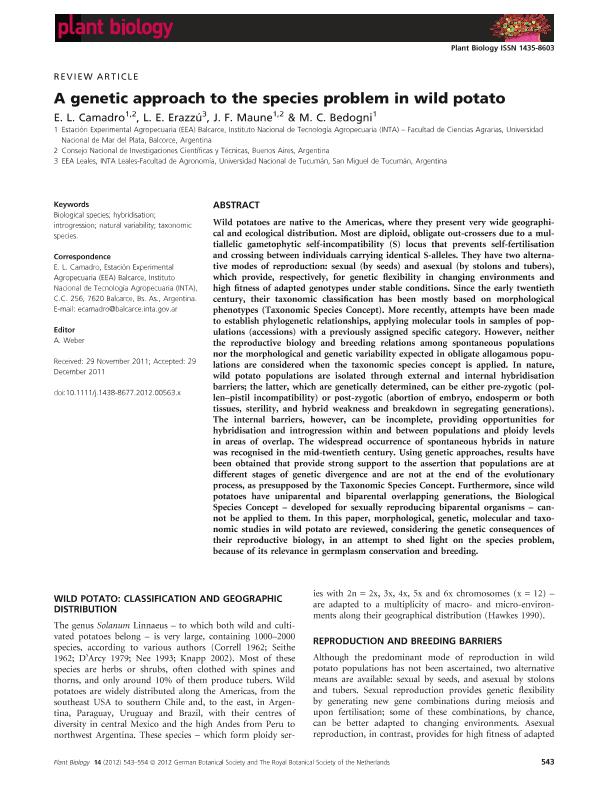Mostrar el registro sencillo del ítem
dc.contributor.author
Camadro, Elsa Lucila

dc.contributor.author
Erazzú, Luis Ernesto

dc.contributor.author
Maune, Juan Federico

dc.contributor.author
Bedogni, María Cecilia

dc.date.available
2023-02-28T10:50:46Z
dc.date.issued
2012-07
dc.identifier.citation
Camadro, Elsa Lucila; Erazzú, Luis Ernesto; Maune, Juan Federico; Bedogni, María Cecilia; A genetic approach to the species problem in wild potato; Wiley Blackwell Publishing, Inc; Plant Biology; 14; 4; 7-2012; 543-554
dc.identifier.issn
1435-8603
dc.identifier.uri
http://hdl.handle.net/11336/189034
dc.description.abstract
Wild potatoes are native to the Americas, where they present very wide geographical and ecological distribution. Most are diploid, obligate out-crossers due to a multiallelic gametophytic self-incompatibility (S) locus that prevents self-fertilisation and crossing between individuals carrying identical S-alleles. They have two alternative modes of reproduction: sexual (by seeds) and asexual (by stolons and tubers), which provide, respectively, for genetic flexibility in changing environments and high fitness of adapted genotypes under stable conditions. Since the early twentieth century, their taxonomic classification has been mostly based on morphological phenotypes (Taxonomic Species Concept). More recently, attempts have been made to establish phylogenetic relationships, applying molecular tools in samples of populations (accessions) with a previously assigned specific category. However, neither the reproductive biology and breeding relations among spontaneous populations nor the morphological and genetic variability expected in obligate allogamous populations are considered when the taxonomic species concept is applied. In nature, wild potato populations are isolated through external and internal hybridisation barriers; the latter, which are genetically determined, can be either pre-zygotic (pollen-pistil incompatibility) or post-zygotic (abortion of embryo, endosperm or both tissues, sterility, and hybrid weakness and breakdown in segregating generations). The internal barriers, however, can be incomplete, providing opportunities for hybridisation and introgression within and between populations and ploidy levels in areas of overlap. The widespread occurrence of spontaneous hybrids in nature was recognised in the mid-twentieth century. Using genetic approaches, results have been obtained that provide strong support to the assertion that populations are at different stages of genetic divergence and are not at the end of the evolutionary process, as presupposed by the Taxonomic Species Concept. Furthermore, since wild potatoes have uniparental and biparental overlapping generations, the Biological Species Concept - developed for sexually reproducing biparental organisms - cannot be applied to them. In this paper, morphological, genetic, molecular and taxonomic studies in wild potato are reviewed, considering the genetic consequences of their reproductive biology, in an attempt to shed light on the species problem, because of its relevance in germplasm conservation and breeding.
dc.format
application/pdf
dc.language.iso
eng
dc.publisher
Wiley Blackwell Publishing, Inc

dc.rights
info:eu-repo/semantics/openAccess
dc.rights.uri
https://creativecommons.org/licenses/by-nc-sa/2.5/ar/
dc.subject
BIOLOGICAL SPECIES
dc.subject
HYBRIDISATION
dc.subject
INTROGRESSION
dc.subject
NATURAL VARIABILITY
dc.subject
TAXONOMIC SPECIES
dc.subject.classification
Biología Reproductiva

dc.subject.classification
Ciencias Biológicas

dc.subject.classification
CIENCIAS NATURALES Y EXACTAS

dc.title
A genetic approach to the species problem in wild potato
dc.type
info:eu-repo/semantics/article
dc.type
info:ar-repo/semantics/artículo
dc.type
info:eu-repo/semantics/publishedVersion
dc.date.updated
2023-02-27T17:43:36Z
dc.journal.volume
14
dc.journal.number
4
dc.journal.pagination
543-554
dc.journal.pais
Reino Unido

dc.journal.ciudad
Londres
dc.description.fil
Fil: Camadro, Elsa Lucila. Instituto Nacional de Tecnología Agropecuaria. Centro Regional Buenos Aires Sur. Estación Experimental Agropecuaria Balcarce; Argentina. Consejo Nacional de Investigaciones Científicas y Técnicas. Centro Científico Tecnológico Conicet - Mar del Plata; Argentina
dc.description.fil
Fil: Erazzú, Luis Ernesto. Instituto Nacional de Tecnología Agropecuaria. Centro Regional Tucuman-santiago del Estero. Campo Experimental Regional Leales; Argentina. Consejo Nacional de Investigaciones Científicas y Técnicas. Centro Científico Tecnológico Conicet - Mar del Plata; Argentina
dc.description.fil
Fil: Maune, Juan Federico. Consejo Nacional de Investigaciones Científicas y Técnicas. Centro Científico Tecnológico Conicet - Mar del Plata; Argentina. Instituto Nacional de Tecnología Agropecuaria. Centro Regional Buenos Aires Sur. Estación Experimental Agropecuaria Balcarce; Argentina
dc.description.fil
Fil: Bedogni, María Cecilia. Consejo Nacional de Investigaciones Científicas y Técnicas. Centro Científico Tecnológico Conicet - Mar del Plata; Argentina. Consejo Nacional de Investigaciones Científicas y Técnicas. Centro Científico Tecnológico Conicet - Mar del Plata; Argentina
dc.journal.title
Plant Biology

dc.relation.alternativeid
info:eu-repo/semantics/altIdentifier/url/http://onlinelibrary.wiley.com/doi/10.1111/j.1438-8677.2012.00563.x/pdf
dc.relation.alternativeid
info:eu-repo/semantics/altIdentifier/doi/http://dx.doi.org/10.1111/j.1438-8677.2012.00563.x
Archivos asociados
